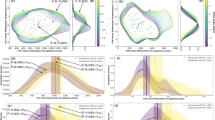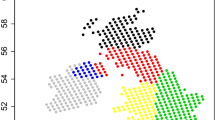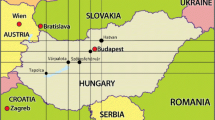Abstract
The impacts of warm season heat extremes are dependent on both temperature and humidity, so it is critical to properly model their relationship, including how it may be changing. This presents statistical challenges because the bivariate temperature–humidity (measured here by dew point) distribution is complex and spatially variable. Here, we develop a flexible, semiparametric model based on quantile smoothing splines to summarize the distributional dependence of dew point on temperature, including how the dependence is changing with increasing global mean temperature. Noncrossing constraints enforce both the validity of the modeled distributions and the physical constraint that dew point cannot exceed temperature. The proposed method is first demonstrated with four synthetic, representative case studies. We then apply it to data from 2416 weather stations spanning the globe, with a focus on analyzing dew point trends during hot days. In general, dew point is increasing on both hot, humid and hot, dry days in the tropics and high latitudes, but decreasing in the subtropics, especially on hot, dry days. These changes appear to be mostly explained by changes in the temperature–dew point relationship, rather than by increases in temperature with a fixed temperature–dew point relationship.





Similar content being viewed by others
References
AghaKouchak, A., L. Cheng, O. Mazdiyasni, and A. Farahmand (2014), Global warming and changes in risk of concurrent climate extremes: Insights from the 2014 California drought, Geophysical Research Letters, 41(24), 8847–8852.
Barreca, A. I. (2012), Climate change, humidity, and mortality in the United States, Journal of Environmental Economics and Management, 63(1), 19–34.
Benjamini, Y., and Y. Hochberg (1995), Controlling the false discovery rate: a practical and powerful approach to multiple testing, Journal of the Royal statistical society: series B (Methodological), 57(1), 289–300.
Bondell, H. D., B. J. Reich, and H. Wang (2010), Noncrossing quantile regression curve estimation, Biometrika, 97(4), 825–838.
Chamaillé-Jammes, S., H. Fritz, and F. Murindagomo (2007), Detecting climate changes of concern in highly variable environments: Quantile regressions reveal that droughts worsen in Hwange National Park, Zimbabwe, Journal of Arid Environments, 71(3), 321–326.
Coffel, E. D., R. M. Horton, and A. de Sherbinin (2017), Temperature and humidity based projections of a rapid rise in global heat stress exposure during the 21st century, Environmental Research Letters, 13(1), 014,001.
Cooley, D., E. Thibaud, F. Castillo, and M. F. Wehner (2019), A nonparametric method for producing isolines of bivariate exceedance probabilities, Extremes, pp. 1–18.
Davis, R. E., G. R. McGregor, and K. B. Enfield (2016), Humidity: A review and primer on atmospheric moisture and human health, Environmental Research, 144, 106–116.
De Michele, C., and G. Salvadori (2003), A generalized Pareto intensity-duration model of storm rainfall exploiting 2-copulas, Journal of Geophysical Research: Atmospheres, 108(D2).
Deser, C., R. Knutti, S. Solomon, and A. S. Phillips (2012), Communication of the role of natural variability in future North American climate, Nature Climate Change, 2(11), 775–779.
Diamond, S., and S. Boyd (2016), CVXPY: A Python-embedded modeling language for convex optimization, The Journal of Machine Learning Research, 17(1), 2909–2913.
Domahidi, A., E. Chu, and S. Boyd (2013), ECOS: An SOCP solver for embedded systems, in 2013 European Control Conference (ECC), pp. 3071–3076, IEEE.
Elsner, J. B., J. P. Kossin, and T. H. Jagger (2008), The increasing intensity of the strongest tropical cyclones, Nature, 455(7209), 92.
Franco-Villoria, M., M. Scott, and T. Hoey (2019), Spatiotemporal modeling of hydrological return levels: A quantile regression approach, Environmetrics, 30(2), e2522.
Gibson, J. F., J. D. Farmer, M. Casdagli, and S. Eubank (1992), An analytic approach to practical state space reconstruction, Physica D: Nonlinear Phenomena, 57(1-2), 1–30.
Guirguis, K., A. Gershunov, A. Tardy, and R. Basu (2014), The impact of recent heat waves on human health in California, Journal of Applied Meteorology and Climatology, 53(1), 3–19.
Hao, Z., V. Singh, and F. Hao (2018), Compound extremes in hydroclimatology: a review, Water, 10(6), 718.
Haugen, M. A., M. L. Stein, E. J. Moyer, and R. L. Sriver (2018), Estimating changes in temperature distributions in a large ensemble of climate simulations using quantile regression, Journal of Climate, 31(20), 8573–8588.
He, X. (1997), Quantile curves without crossing, The American Statistician, 51(2), 186–192.
He, X. (2017), Resampling methods, in Handbook of quantile regression, edited by R. Koenker, V. Chernozhukov, X. He, and L. Peng, pp. 7–19, Chapman and Hall/CRC.
Hsiao, J., A. L. Swann, and S.-H. Kim (2019), Maize yield under a changing climate: The hidden role of vapor pressure deficit, Agricultural and Forest Meteorology, 279, 107,692.
Katz, R. W., M. B. Parlange, and P. Naveau (2002), Statistics of extremes in hydrology, Advances in Water Resources, 25(8-12), 1287–1304.
Koenker, R., and G. Bassett Jr (1978), Regression quantiles, Econometrica: journal of the Econometric Society, pp. 33–50.
Koenker, R., P. Ng, and S. Portnoy (1994), Quantile smoothing splines, Biometrika, 81(4), 673–680.
Lee, E. R., H. Noh, and B. U. Park (2014), Model selection via Bayesian information criterion for quantile regression models, Journal of the American Statistical Association, 109(505), 216–229.
Liu, Y., and Y. Wu (2009), Stepwise multiple quantile regression estimation using non-crossing constraints, Statistics and its Interface, 2(3), 299–310.
Lum, K., and A. E. Gelfand (2012), Spatial quantile multiple regression using the asymmetric Laplace process, Bayesian Analysis, 7(2), 235–258.
Machado, J. A. F., and J. S. Silva (2005), Quantiles for counts, Journal of the American Statistical Association, 100(472), 1226–1237.
Mastrangelo, G., U. Fedeli, C. Visentin, G. Milan, E. Fadda, and P. Spolaore (2007), Pattern and determinants of hospitalization during heat waves: an ecologic study, BMC Public Health, 7(1), 200.
McKinnon, K. A., and C. Deser (2018), Internal variability and regional climate trends in an observational large ensemble, Journal of Climate, 31(17), 6783–6802.
McKinnon, K. A., A. Rhines, M. P. Tingley, and P. Huybers (2016), The changing shape of Northern Hemisphere summer temperature distributions, Journal of Geophysical Research: Atmospheres, 121(15), 8849–8868.
Meehl, G. A., and C. Tebaldi (2004), More intense, more frequent, and longer lasting heat waves in the 21st century, Science, 305(5686), 994–997.
Miralles, D. G., A. J. Teuling, C. C. Van Heerwaarden, and J. V.-G. De Arellano (2014), Mega-heatwave temperatures due to combined soil desiccation and atmospheric heat accumulation, Nature geoscience, 7(5), 345.
Nelsen, R. B. (2007), An introduction to copulas, Springer Science & Business Media.
Ouarda, T. B., and C. Charron (2019), Changes in the distribution of hydro-climatic extremes in a non-stationary framework, Scientific Reports, 9(1), 1–8.
Pal, J. S., and E. A. Eltahir (2016), Future temperature in southwest Asia projected to exceed a threshold for human adaptability, Nature Climate Change, 6(2), 197.
Perkins, S., L. Alexander, and J. Nairn (2012), Increasing frequency, intensity and duration of observed global heatwaves and warm spells, Geophysical Research Letters, 39(20).
Reich, B. J. (2012), Spatiotemporal quantile regression for detecting distributional changes in environmental processes, Journal of the Royal Statistical Society: Series C (Applied Statistics), 61(4), 535–553.
Reich, B. J., M. Fuentes, and D. B. Dunson (2011), Bayesian spatial quantile regression, Journal of the American Statistical Association, 106(493), 6–20.
Rhines, A., M. P. Tingley, K. A. McKinnon, and P. Huybers (2015), Decoding the precision of historical temperature observations, Quarterly Journal of the Royal Meteorological Society, 141(693), 2923–2933.
Rhines, A., K. A. McKinnon, M. P. Tingley, and P. Huybers (2017), Seasonally resolved distributional trends of North American temperatures show contraction of winter variability, Journal of Climate, 30(3), 1139–1157.
Ribeiro, A. F., A. Russo, C. M. Gouveia, and P. Páscoa (2019), Copula-based agricultural drought risk of rainfed cropping systems, Agricultural Water Management, 223, 105,689.
Rind, D. (1999), Complexity and climate, Science, 284(5411), 105–107.
Rohde, R., R. Muller, R. Jacobsen, S. Perlmutter, A. Rosenfeld, J. Wurtele, J. Curry, C. Wickham, and S. Mosher (2013), Berkeley Earth temperature averaging process, Geoinformatics & Geostatistics: An Overview, 1(2), 1–13.
Schoof, J., S. Pryor, and T. Ford (2019), Projected changes in United States regional extreme heat days derived from bivariate quantile mapping of CMIP5 simulations, Journal of Geophysical Research: Atmospheres.
Seager, R., A. Hooks, A. P. Williams, B. Cook, J. Nakamura, and N. Henderson (2015), Climatology, variability, and trends in the US vapor pressure deficit, an important fire-related meteorological quantity, Journal of Applied Meteorology and Climatology, 54(6), 1121–1141.
Smith, S. J., J. Edmonds, C. A. Hartin, A. Mundra, and K. Calvin (2015), Near-term acceleration in the rate of temperature change, Nature Climate Change, 5(4), 333.
Tanner, C. B., and T. R. Sinclair (1983), Efficient water use in crop production: research or re-search?, in Limitations to efficient water use in crop production, edited by H. M. Taylor, W. R. Jordan, and T. R. Sinclair, pp. 1–27, American Society of Agronomy, Madison, WI.
Wahl, T., S. Jain, J. Bender, S. D. Meyers, and M. E. Luther (2015), Increasing risk of compound flooding from storm surge and rainfall for major US cities, Nature Climate Change, 5(12), 1093.
Wahlstrom, M., and D. Guha-Sapir (2015), The human cost of weather-related disasters, 1995–2015, Tech. rep., Geneva, Switzerland.
Whan, K., J. Zscheischler, R. Orth, M. Shongwe, M. Rahimi, E. O. Asare, and S. I. Seneviratne (2015), Impact of soil moisture on extreme maximum temperatures in Europe, Weather and Climate Extremes, 9, 57–67.
Zscheischler, J., S. Westra, B. J. Van Den Hurk, S. I. Seneviratne, P. J. Ward, A. Pitman, A. AghaKouchak, D. N. Bresch, M. Leonard, T. Wahl, et al. (2018), Future climate risk from compound events, Nature Climate Change, 8(6), 469.
Acknowledgements
AP received support from the Hewlett Mellon Fellowship from Carleton College.
Author information
Authors and Affiliations
Corresponding author
Additional information
Publisher's Note
Springer Nature remains neutral with regard to jurisdictional claims in published maps and institutional affiliations.
Electronic supplementary material
Below is the link to the electronic supplementary material.
Matrix form of Noncrossing Quantile Smoothing Splines
Matrix form of Noncrossing Quantile Smoothing Splines
In order to solve for the parameters in our regularized quantile smoothing splines model with noncrossing constraints, we write it in standard form as follows:

and describe each term in this optimization problem below.
Throughout this appendix, bold face implies a two-dimensional matrix, whereas normal script indicates a vector or, in the case of \(\tau \) and \(\lambda \), a constant. Note that this stands in contrast to the main text, where vectors are bolded, in order to more clearly indicate the relevant matrix operations.
The parameter vector \({z}\) and cost vector \({c}\) are,
where the m model parameters are contained in \({\theta }\) and the remaining components of \({z}\) are the values of the residuals (\(\epsilon \)’s) and the second derivatives of the \({\alpha }_0\) (u’s) and \({\alpha }_1\) values (v’s), which are the fitted splines at each knot. The superscripts \(+\) and − denote the magnitude of the positive and negative components, respectively, such that, e.g., \({\theta } = {\theta }^+ - {\theta }^-\). The cost vector contains the minimization of Eq. (3), with no penalty on the values of \({\theta }\), a quantile-weighted penalty on the residuals, and the \(\lambda \)-weighted penalty on the second derivatives of the splines.
The equality term, \(\mathbf {A}{z}={b}\), is written as,
where the matrix \(\mathbf {X}\) is the design matrix for Eq. (2), the \(\mathbf {D}_k\) are the second derivative operators for the spline coefficients, \({\alpha }_k\), and the length (dimensions) of the vectors (matrices) of zeros and ones are indicated by the subscripts. Thus, the first row of \(\mathbf {A}\) contains the constraint that the data minus the conditional quantile fit equals the residuals. The second and third rows define that the second derivate of the spline coefficients equal \({u}\) and \({v}\), respectively.
Finally, all noncrossing constraints, as well as the standard constraint that all are in the inequality term, \(\mathbf {G}{z}\le {h}\). Define \(c=2m+2n+4\times (n-1)\) as the length of z. Then, for the median quantile, \(\tau = 0.5\),
where \({T}\) is the vector of sorted local temperatures. The first row of \(\mathbf {G}\) constrains all parameter values in \({z}\) to be positive, whereas the second row ensures that the conditional quantile of dew point does not exceed temperature.
For quantile levels above the median, \(\tau _{i} = 0.5 + \delta _i\), where \(\delta _i\) is positive and increasing, define \({q}\) as the best fit conditional quantile for the \(\tau _{i-1}\) quantile. Then the inequality constraint is slightly modified to:
where the last row in \(\mathbf {G}\) is the noncrossing constraint for consecutive quantiles.
Finally, for quantile levels below the median, \(\tau _{i} = 0.5 + \delta _i\), where \(\delta _i\) is negative and decreasing, define \({q}\) as the best fit conditional quantile for the \(\tau _{i-1}\) quantile. In this case, we can remove the constraint that the conditional dew point quantile is less than the local temperature because it will already be contained within the noncrossing constraint. Thus, the inequality constraint is:
Rights and permissions
About this article
Cite this article
McKinnon, K.A., Poppick, A. Estimating Changes in the Observed Relationship Between Humidity and Temperature Using Noncrossing Quantile Smoothing Splines. JABES 25, 292–314 (2020). https://doi.org/10.1007/s13253-020-00393-4
Received:
Accepted:
Published:
Issue Date:
DOI: https://doi.org/10.1007/s13253-020-00393-4




